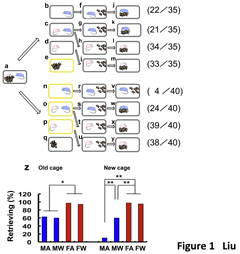- Home
- Highlights
- Uncovering maternal to paternal communications in mice
Highlights
Uncovering maternal to paternal communications in mice
Researchers at Japan’s Kanazawa University have proven the existence of communicative signalling from female mice that induces male parental behavior.
Most mammalian parents use communicative signals between the sexes, but it is uncertain whether such signals affect the levels of parental care in fathers. Scientists have long suspected that female mice play a definite role in encouraging paternal relationships between male mice and their pups.
Now, a research team at Kanazawa University led by Haruhiro Higashida in collaboration with scientists across Japan, Russia and the UK, have proven the existence of auditory and olfactory (smell) signals produced by females which actively trigger paternal activity in males.
Higashida and his team conducted a series of experiments with females and males living in established family groups. Pups were removed from the cage for a short time, while one or both parents remained in the nest. The pups were then returned to the cage, away from the nest. Lone females nearly always brought the pups back to the nest, but lone males were less likely to do so.
Most interestingly, the researchers showed that males were much more likely to retrieve pups when they remained with their mate. This behavior may be related to ultra-sonic noises emitted by females under stress. These sounds are not emitted by males, pups or non-parental females, and they encouraged the males into parental behaviors. The females also released olfactory signals in the form of pheromones, which triggered the same reaction in the males.
Higashida and his team are keen to expand on their results by analyzing neural signalling in the male brain in response to these female communications.
Publication and Affiliation
Hong-Xiang Liu1,2, Olga Lopatina1,2,3, Chiharu Higashida2, Hiroko Fujimoto2, Shirin Akther2, Alena Inzhutova ⱡ 2,3,, Mingkun Liang2, Jing Zhong2, Takahiro Tsuji2, Toru Yoshihara1,4,5, Kohei Sumi2, Mizuho Ishiyama2,Wen-Jie Ma2, Mitsunori Ozaki6, Satoshi Yagitani6, Shigeru Yokoyama1,2,4, Naofumi Mukaida7, Takeshi Sakurai8, Osamu Hori9, Katsuji Yoshioka10, Atsushi Hirao11, Yukio Kato12, Katsuhiko Ishihara13, Ichiro Kato14, Hiroshi Okamoto15, Stanislav M. Cherepanov3, Alla B. Salmina3, Hirokazu Hirai16, Masahide Asano1,5, David A. Brown17, Isamu Nagano6 & Haruhiro Higashida*1,2,3,4. Displays of paternal mouse pup retrieval following communicative interaction with maternal mates. Nature Communications 4:1346 (2013) DOI: 10.1038/ncomms2336
Link
1.Kanazawa University 21st Century COE Program on Innovative Brain Science on Development, Learning and Memory, Kanazawa 920-8640, Japan.
2. Department of Biophysical Genetics, Kanazawa University Graduate School of Medicine, Kanazawa 920-8640, Japan.
3.Department of Biochemistry, Medical, Pharmaceutical and Toxicological Chemistry, Krasnoyarsk State Medical University, Krasnoyarsk 660022, Russia.
4.Osaka-Hamamatsu-Kanazawa Universities Joint Research Centre, Departments of Basic and Clinical Research on Sociocognition and Memory, Kanazawa Centre for Child Mental Development, Kanazawa 920-8640, Japan.
5.Advanced Science Research Centre, Kanazawa University, Kanazawa 920-8640, Japan.
6.Division of Electrical Engineering and Computer Sciences, Graduate School of Natural Science and Technology, Kanazawa University, Kanazawa 920-1192, Japan.
7.Division of Molecular Bioregulation, Cancer Research Institute, Kanazawa University, Kanazawa 920-1192, Japan.
8.Department of Molecular Neuroscience and Integrative Physiology, Kanazawa University Graduate School of Medicine, Kanazawa 920-8640, Japan.
9.Department of Neuroanatomy, Kanazawa University Graduate School of Medicine, Kanazawa 920-8640, Japan.
10.Division of Molecular Cell Signalling, Centre for Cancer Research Institute, Kanazawa 920-1192, Japan.
11.Division of Molecular Genetics, Centre for Cancer and Stem Cell Research, Cancer Research Institute, Kanazawa University, Kanazawa 920-1192, Japan.
12.Laboratory of Molecular Pharmacotherapeutics, Division of Pharmaceutical Sciences, Graduate School of Natural Science and Technology, Kanazawa University, Kanazawa 920-1192, Japan.
13.Department of Immunology and Molecular Genetics, Kawasaki Medical University, Kurashiki 701-0192, Japan.
14.Department of Biochemistry, University of Toyama Graduate School of Medicine and Pharmaceutical Sciences, Toyama 930-0194, Japan.
15.Department of Advanced Biological Sciences for Regeneration, Tohoku University Graduate School of Medicine, Sendai 980-8575, Japan.
16.Department of Neurophysiology, Gunma University Graduate School of Medicine, Maebashi, Gunma 371-8511, Japan.
17.Department of Neuroscience, Physiology and Pharmacology, University College London, London WC1E 6BT, UK.
*corresponding author, e-mail address: haruhiro@med.kanazawa-u.ac.jp
ID: 201302H015

